
Things we like
- Phenomenal handling
- Mighty V8 twin-turbo engine
- Sense of occasion
- Depth of engineering
Not so much
- Demands a lot from its driver to get the best from it
- Gearshift logic a little idiosyncratic
- They're all sold anyway
This is going to take some explaining. Just ten minutes earlier, the affable Mercedes-AMG PR man had been regaling me with the fact that this AMG GT Black Series costs $796,100 and that there are over $230,000 of taxes to pay on top of that, making it an easy $1m+ car on the road. Now I’m about to remodel it.
I’m steaming in to Hayshed, a big commitment right hander. Turn in good, apex nailed. I gently open the steering to let the car run out to the left hand side of the track when an ibis decides now is a good time to merge onto the circuit. Instructor Sam Brabham flinches reflexively as I accept that attempting to avoid the suicidal bin chicken is only going to make a bad situation worse. It’s coming through the windscreen straight into Brabham’s face, before flaring its wings and passing over the door mirror, a tumbling whorl of feathers and legs in the vortices streaming off the car.
We’re both a bit shaken. There’s a greasy smear of some kind of unidentifiable bird juice atop the mirror housing but apart from that the car is unscathed. I bring it into the pits to decompress and avail myself of a party pie. The AMG GT Black Series is one of those cars that isn’t easy to sum up in a sentence.
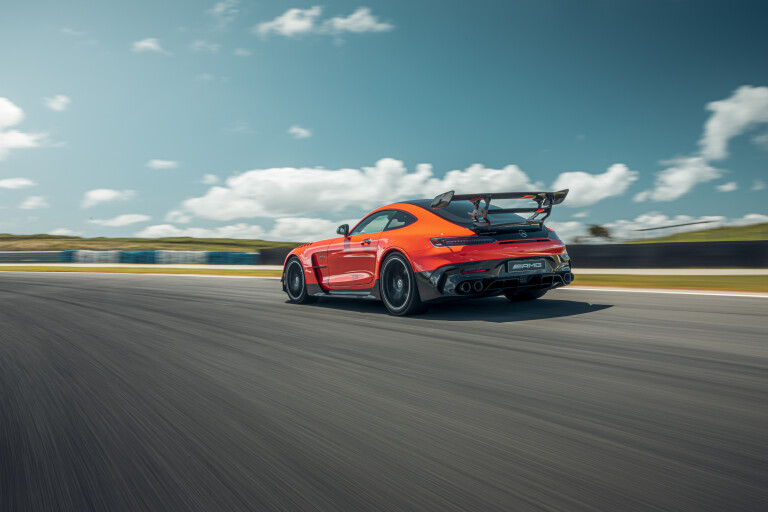
To all intents and purposes, it’s an end stop. It’s the last of the great internal combustion AMG sports cars and, to that end, Affalterbach has thrown everything it knows at the Black Series. Engine, aero, suspension, software, brakes, tyre tech – everything. The price almost becomes an irrelevance. Only 28 are coming to Australia, they’ve all been sold and there will never be another road car that wears the three-pointed star to equal it. From here, AMG’s evolutionary path diverges.
The bald facts you probably know. The M178 LS2 4.0-litre V8 engine has been extensively reworked, now featuring a flat-plane crank, and it develops 537kW @ 6700-6900rpm, a massive 107kW more than the GT R Pro that’s our current Performance Car of the Year. Torque is rated at 800Nm anywhere between 2000 and 6000rpm, all that drive going to the rear wheels via a carbon torque tube that provides the impetus for a seven-speed dual clutch ‘box, mounted aft in a transaxle arrangement.
So far, so impressive. What we’re here for is to find out what this technical tour-de-force is like to drive, hard. Four-point harnesses cinched, front splitter jutting forth in Race setup and a deserted Phillip Island Grand Prix circuit at our disposal, it’s time to find out.

The engine settles to an urgent chunter at idle. Unlike the GT R, there’s no cross-plane woofle. It sounds what it is, a pair of fused two-litre four-pots, firing order 1-8-2-7-4-5-3-6. Headroom is surprisingly good when seated in the fixed-back carbon buckets, even with an Arai lid on. Nudge the rear-set stub of a gear-lever into drive with your elbow and head out of the pit lane.
After easing into a warm-up lap in an attempt to respark muscle memory dulled after months of lockdown, it’s clear that this is a very different confection to the GT R Pro. It thrives on revs, and there’s a sharp step change in the acoustic signature at 6000rpm that turns what was a fast car into a feral one. There’s no great beauty to the engine note, but accompanied by intake roar and the buzz saw-like stainless-steel exhaust, there is a lot going on. What was already a ferocious and intense experience ramps up dramatically. It’s like VTEC by Charles Manson. Unlike the manic, barely conceivable scrabble of a McLaren 720S, the GT Black Series feels better anchored and more effectively transfers that torque to the rear treads. It takes a couple of laps to figure out how.
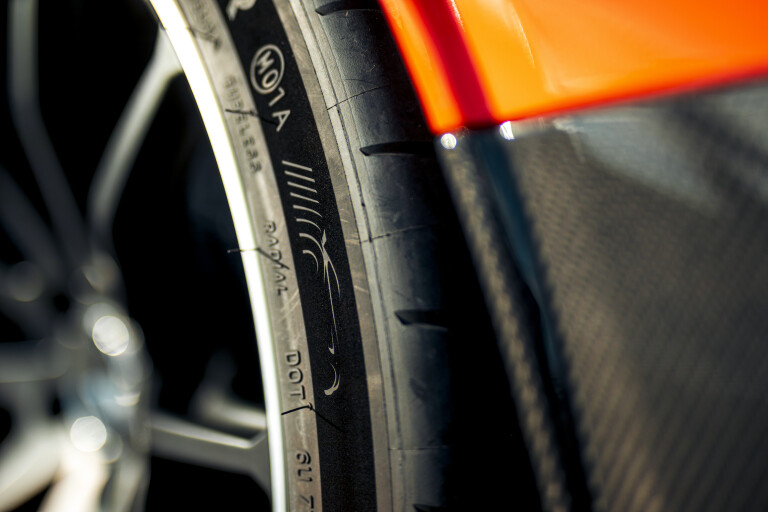
The tyres are a big part of it. It’s riding on Michelin Pilot Sport Cup 2 R rubber in a special compound developed for this car. Look closely at the sidewalls of the Mercedes Original ‘MO1A’ soft compound tyre and you’ll see a laser-cut silhouette of the Black Series. You probably won’t find these at Bob Jane’s.
Then there’s the aero package. The bi-plane rear wing with active centre flap helps develop more than 400kg of downforce at 250km/h when set into its most aggressive angle of attack. For reference the McLaren Senna develops 800kg and an F1 car around 2500kg at the same speed. Moving forward, the underbody is almost entirely flat, with longitudinal fins channelling air to the rear diffuser. The front end is a riot of flics, intakes, and huge air vents in the bonnet and over the front wings. The jutting front diffuser features an elastic inverted aerofoil that further increases downforce on the front axle.
In fast corners, there’s a moment where you expect the Black Series to have teetered into understeer, but it doesn’t come. You can provoke it with throttle as the nose lifts slightly, but keep the car level and you have a seemingly impossible envelope of additional steering input available to you. Throw the Black Series into Turn 2 at Phillip Island and it’s possible to rotate the car into the second apex, square off the line out of the corner and get onto the throttle earlier than you’d ever deem possible.

Leaning into that aero advantage is a steep learning curve and after a few laps, I’m only beginning to get an appreciation of where this car’s limits reside. The carbon ceramic brakes are mighty and don’t have any issue shucking off the Black’s 1520kg mass at 280km/h at the end of the start/finish straight. The only dynamic peccadillo that would irk me is the transmission’s insistence of holding a gear, in this case out of Honda and into Siberia, whereupon on throttle demand it would shift down a couple of ratios with a moment’s pause followed by a huge and amateurish-sounding gout of revs. The simple solution is to pluck the gears yourself.
The steering feels lantern-jawed and a little mute, but there’s decent heft to the wheel and the way that the engine is set back in the body means that the balance doesn’t feel typically long bonnet point-and-squirty to drive. I can’t say I got a handle on the attributes of the three-stage adaptive damping on a smooth race track, but body control is excellent, offering just enough reassurance in pitch and roll to key you into shifting the masses around to your advantage.
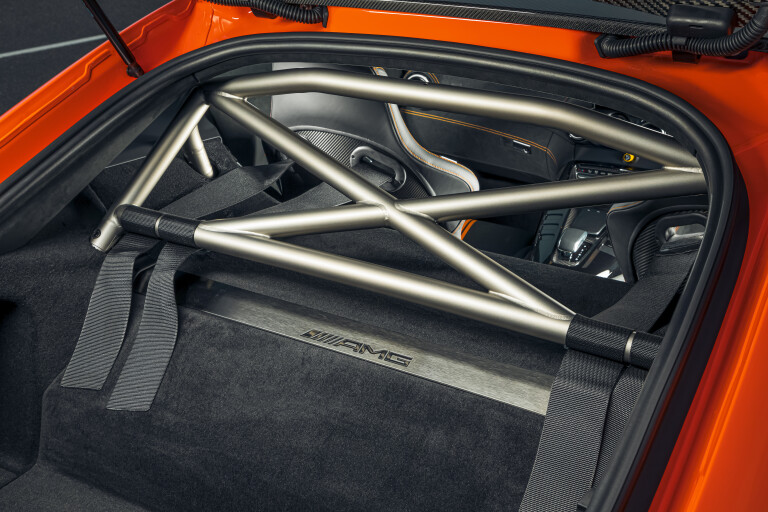
Both anti-roll bars are manually adjustable, as is the camber on both front and rear axles, AMG supplying a custom shim set with the vehicle. Also standard (but an option in other markets) is the AMG Track Package, which comprises a titanium roll bar, those four-point harnesses which, incidentally, retain the inertia-reel belt, and a 2kg fire extinguisher in the passenger footwell.
Amazingly, the straight line performance of a car that can dispatch 200km/h from rest in less than nine seconds is far from the most impressive aspect of the AMG GT Black Series. Affalterbach has built a car as close to a street-legal GT3 racing car as it dares. Of course, there will be those who point out that for $1m, you could buy a lightly-used GT3 car and enjoy the slick-shod benefits of the real thing at a race track of your choice, but that is to ignore what this car is and what it means.
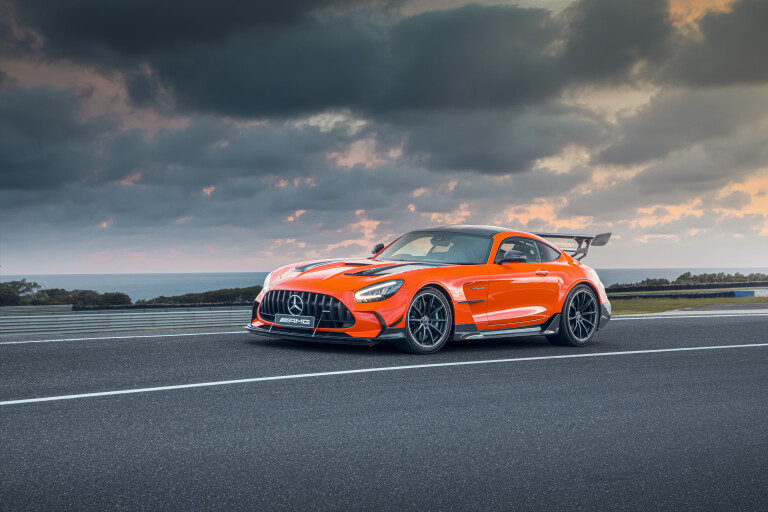
This is AMG’s line in the sand, a statement of everything the company knows about internal combustion-powered sports cars. As such, it will never be bettered. As a performance car, it stands comparison with the best that Porsche’s GT division can build right now. That may change as and when Porsche decides to throw all of their know-how at an ICE final special. For the time being, the GT Black Series is one heck of a love letter to AMG’s motorsport tradition and the art of the internal combustion engine.
Moers' Crystal Ball
Cast your mind back to 2012 when AMG launched the last of the Black Series cars, the SLS AMG Black Series. Only 12 of these gull-winged coupes ever made it to these shores, making it one of the most sought-after cars of its generation.
Ignore that for a moment, and consider what then-boss Tobias Moers was briefing behind the scenes. He forecasted the power and torque for the next Black Series to emerge and predicted – virtually to the second – the 6m46s Nordschleife lap time that the AMG GT Black Series would achieve a dozen years down the track.
Light, Fantastic
As well as carbon fibre bonnet, roof and tailgate, the AMG GT Black Series also features thinner glass, polycarbonate windows at the back, a carbon fibre torque tube, carbon fibre transmission subframe, forged aluminium wishbones, steering knuckles and hub carriers, as well as a lightweight titanium bolt-in roll cage.
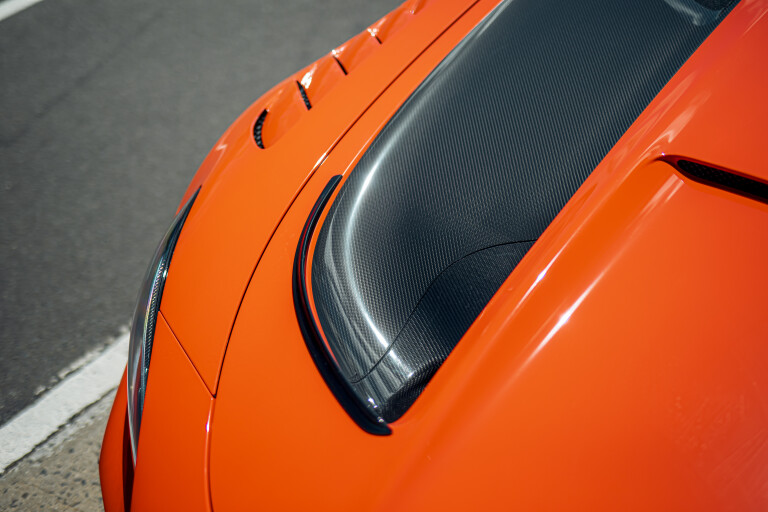
Power Up
The flat-plane M178 LS2 engine also features new camshafts and exhaust manifolds as well as significantly bigger turbochargers compared to those fitted to the GT R. Featuring a larger compressor wheel, the Black Series’ turbochargers can ladle a total of 1100kg of air per hour compared to the 900kg/h of the GT R.
Bigger intercoolers guarantee that the charge-air temperature is kept as low as possible. This engine adheres to AMG’s ‘one person, one engine’ build philosophy, and only six people at Affalterbach are qualified to build the M178 LS2.
2022 Mercedes-AMG GT Black Series
| BODY | 2-door, 2-seat coupe |
|---|---|
| DRIVE | Rear-wheel |
| ENGINE | 3982cc V8, DOHC, 32v, biturbo |
| POWER | 537kW @ 6700-6900rpm |
| TORQUE | 800Nm @ 2000-6000rpm |
| POWER/WEIGHT | 353kW/tonne |
| TRANSMISSION | 7-speed dual-clutch |
| WEIGHT | 1520kg |
| L/W/H | 4551/2007/1284mm |
| WHEELBASE | 2630mm |
| STEERING | Electronically assisted rack-and-pinion |
| TYRES | 285/35 ZR19 (f); 335/30 ZR20 (r) Michelin Pilot Sport Cup 2 R |
| PRICE | $796,100 + ORC |
Things we like
- Phenomenal handling
- Mighty V8 twin-turbo engine
- Sense of occasion
- Depth of engineering
Not so much
- Demands a lot from its driver to get the best from it
- Gearshift logic a little idiosyncratic
- They're all sold anyway



COMMENTS